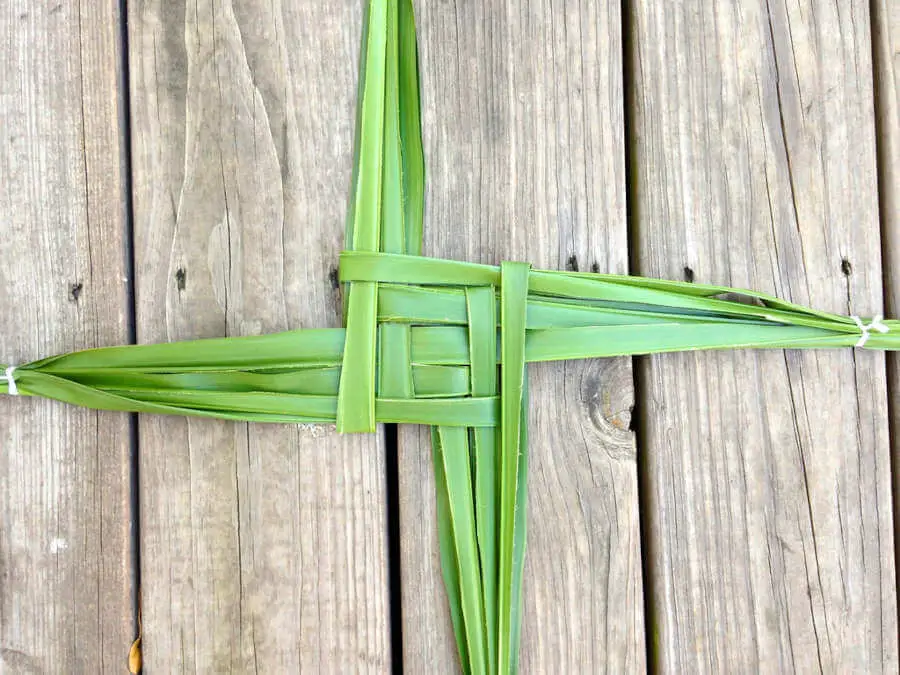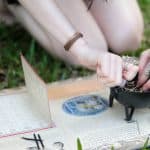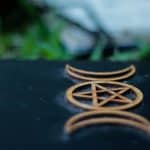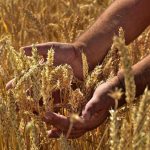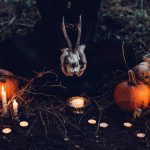The beginning of spring is a special time to celebrate the end of the harsh winter weather and the return of sunshine and warmer days. Ancient cultures worldwide had festivals that marked this period, and it was associated with spirituality, rebirth, and festivities.
One of the most significant spring festivals was Imbolc which has Gaelic roots and has been influential even in modern times. Here is a look at its origins, practices, and rituals.
Imbolc Origins and History
The earliest traces place the Imbolc celebration origin around the Neolithic period. That was way before Christianity was introduced in Ireland in the fifth century. The exact etymology or origin of the word is not clear, but most sources suggest it comes from the Old Irish “i mbolc” meaning “in the belly,” referring to the fact that the ewes were pregnant during this period in the year.
Whatever the origin of the word, there is no doubt it was an important period, especially in the agricultural calendar, being a time associated with the lambing period and preparation for spring sowing. Imbolc is one of the four Gaelic seasons, including Beltane on May 1, Lughnasadh on August 1, and Samhain on November 1.
Besides its agricultural associations, it was also a time for ritual cleansing, seeking blessings, and festival affairs. To this day, the celebration continues to have an influence, especially on Christian events like St. Brigid’s Day and Candlemas.
Related Reading: The 8 Major Annual Wiccan Holidays (Sabbats) – Opens in new tab
From Goddess Brigid to Saint Brigid
Celebration of Imbolc revolved around Brigid and was in practice long before Christianity came to the Celtic lands. Brigid is a goddess in the Celtic Pantheon, a daughter of the Dagda, and one of the most powerful gods given her many powers and attributes. She is depicted as being born with a flame in her head, while other accounts say the flame rose from her head when she descended to earth.
The flame makes her the patron or guardian over scholars, creators like poets and craftspeople, metalsmithing, etc. She is also the goddess of the hearth and forges, guardian of nature, and protector of wells and springs. During her childbirth, she drank milk from a mystical cow, and as a result, she gained the powers of prophecy. She is also the goddess of agriculture.
Ancient Imbolc practices featured rituals to invite Brigid to people’s homes, visiting wells, lighting fires and candles in tribute to Brigid. Effigies of the goddess would also be made, and people would also leave offerings for her.
When Christianity came to the land, it was easier to adopt Imbolc and Brigit into the early Christian traditions than ban them. Thus, it became St Brigid’s day, and the goddess became a saint. According to the church, Brigid was a real person born around 453 AD and died around 524 AD. The historical accounts are given, though they have her associated with the same attributes as the goddess.
For example, she was celebrated at an early age for her agricultural knowledge. According to her story, she was the daughter of a slave and a chieftain. She was baptized by St Patrick and became a nun (Ireland’s first nun). She led a band of other nuns to build a convent at Kildare, which had earlier been a holy site dedicated to the goddess Brigid. Legend has it that a fire burned for 500 years manned by nuns at the site, and it never removed ash.
Modern-day celebrations of St. Brigid’s Day resemble the practices for honoring the goddess Brigid. These include making Brigid crosses and dolls, lighting candles and fires, and making beds for Brigid to invite her presence in the house. She is now among the three patron saints of Ireland.
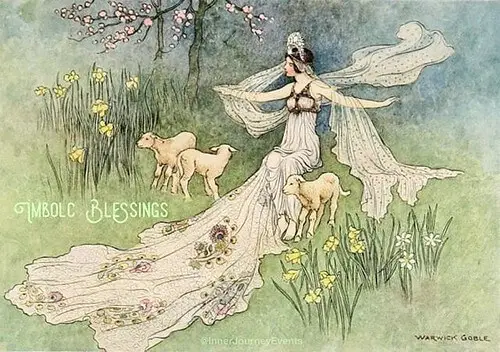
Imbolc Traditions & Celebration – How to celebrate Imbolc
There are different ways you can celebrate Imbolc. Celebrations are aimed at venerating St. Brigid, cleansing yourself and your home, performing prayers, and being receptive to the new energy and blessings coming over that season. Some ideas for celebrating Imbolc are;
- Perform a ritual cleansing bath to start your other activities
- Perform an Imbolc house cleansing ceremony
- Make Brigid dollies and crosses for protection
- Create an Imbolc altar with the right herbs, crystals, and color decor
- Bake oatcakes and leave them outside along with milk for Brigid on the eve of Imbolc
- Prepare traditional Imbolc foods like Bannock, Butter, Milk, Cheese, Pancakes, and Colcannon.
- Plant seeds in a pot or garden representing your dreams, hopes, and ideas and nurture them
- Light a fire and gather around with family and friends to reflect or perform a fire-scrying ritual.
Imbolc Symbols
Imbolc symbols indicate the time for the festival, are objects of worship, or making them is part of celebrations, rituals, and traditions of Imbolc. The main Imbolc signs include;
The Swan
Because they mate for life and their association with the goddess Brigid, swans symbolize faithfulness, loyalty, and fidelity. Carved swan symbols decorate the altar or are used to create powerful amulets.
The Flame/fire
Brigid is the goddess of fire, among other things, and the flame symbolizes both her inspiration to creators and her protection indicated by the hearth fire. Flame symbols also represent her fire wheel and her position as the Sun goddess.
Brigid’s Cross
It is a traditional symbol for the fire festival, and it is associated with providing protection. Brigid’s Cross adorns hearths and doors, symbolizing the goddess as the source of fire and protection of the home.
Brigid’s Doll
They symbolize the presence of the goddess in the celebrations, and it is a way to honor and invite her to your home. They are made from straw and adorned with greenery and flowers from nature.
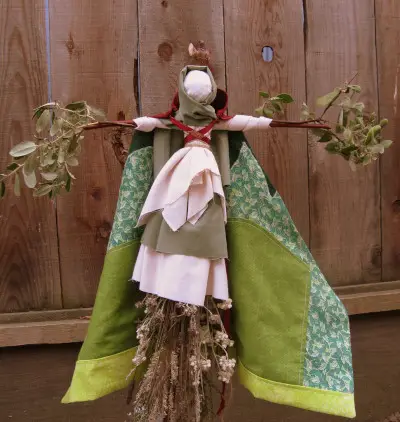
The Snowdrop
It is the first flower of spring and symbolizes the coming of spring, and it is regarded as the first gift of spring in the bleak of winter.
The Serpent
In Celtic mythology, Brigid awakens the serpent hibernating during Imbolc, leaving its lair. The serpent is associated with inspiration and creativity. The energy paths of the earth were called serpent paths and were believed to awaken during Imbolc.
Sheep
The sheep represent other domestic herd animals which are also the focus of the celebrations. Sheep get prominence because they signal the coming of spring as Imbolc coincided with the lambing season.
The lambing sheep provided milk which was used in place of cow milk as, during this period, food was still scarce, and it was easier to provide for sheep than cows till later when the grazing fields were available and nourished.
Milk
Milk is also associated with Imbolc, and it is a representation of life as well as a source of sustenance for the communities. It also served as a sign for the preparation of spring planting. Once the milk started flowing, it was time to begin blessing farm tools and seeds and other rituals to ensure abundant harvest before planting.
Maidens
Maidens and virgins denote fertility and purity and are seen as manifestations of the goddess Brigid. In some communities, some activities or rituals were reserved exclusively for them.
Do you want to learn more about Wicca and Witchcraft? Check out our recommendations at “Wiccan Bookshelf”
Imbolc Colors
Imbolc colors are largely associated with the festival’s theme, and you use them in your dress, candles, altar décor, dolls, and other items. The three main Imbolc colors are;
White
There is plenty of symbolism and use with the white color, and it is the dominant of the Imbolc colors. It represents purity, virginity, and the goddess. Maidens and girls wore white, as is the dress of the goddess. White also is the color of milk, another major symbol of Imbolc and the snowdrop. The goddess also has a white wand and a white cow with red ears in mythology. Silver can be used in place of or along with white.
Red
Red is another dominant color and largely represents fertility. It is the red blood at childbirth and in the menstrual cycle. It is also present in flames and can represent the fires and their energy during this period. Yellow, orange, and pink are other colors that can represent fire or flames.
Green
Green is also a symbol of fertility and the land which is blessed during this season in preparation for planting.
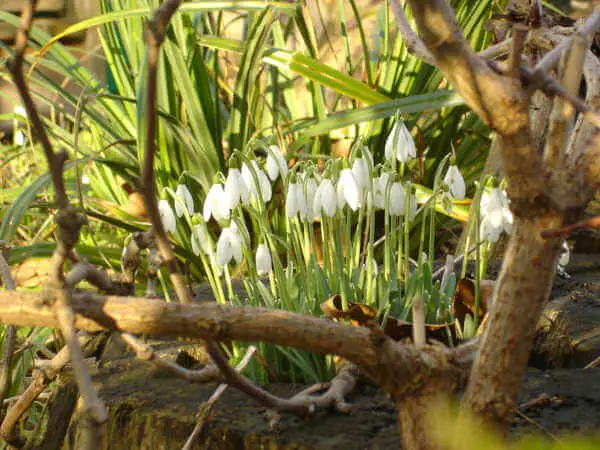
Imbolc sacred plants & Herbs
The sacred plants and herbs are used for making drinks and incense, while their oils used for anointing the Imbolc crosses, the altar, and even yourself during cleansing. You could also use them for decorations. Top plants to use for Imbolc include;
Blackberry:
Blackberry is a goddess plant, and it belongs to the Venus planetary sphere. It is sacred to Brigid, associated with prosperity and healing. Both its fruits and leaves are used during Imbolc.
Coltsfoot
It is another herb associated with Brigid and Venus. It is used to bring peace and engender love. It also has attributes to remove physical and emotional stagnation.
Ginger
It matches the fiery elements of the season, helping revitalize and stimulate the fire within oneself. It also helps maintain the alignment with the serpent energy rising at this point of the year.
The Willow Tree
It is associated with the maiden part of the Triple Goddess and the lunar cycle. It influences emotion and consciousness and facilitates movement and change. It thus inspires imagination and the confidence to follow your intuition.
The Rowan Tree
The Rowan tree is assigned to the spring season in the Celtic tree alphabet. It is also called the Quickening Tree and is associated with the Maiden in the Tripple Goddess and serpents. The tree provides protection and wards off evil. The berries have a small five-pointed star like the pentagram adding to its spiritual properties. You can have a sprig of the tree next to your door for protection.
Imbolc Deities
Imbolc deities are always associated with fertility, protection, and creation. While the celebration is largely Celtic, other places did have versions that celebrated the coming of spring and thus are also worshipped by modern-day pagans. Some of the main deities include;
Brigid
She is the main goddess celebrated here as the guardian of the flame, goddess of fertility, and the protector of the home. She is one of the most powerful Celtic goddesses and is the center of the festivals. She is also revered as the goddess of poetry and crafts.
Cerridwen
She is a Celtic goddess with powers of prophecy and wisdom. She is also granted the status of the Crone in the Triple goddess. At times, she serves as both mother and Crone. She is also associated with the full moon.
Aenghus Og
He is a young Celtic god associated with youthful beauty, love, and poetic inspiration. In mythology, he turned himself into a swan to identify and free his lover, the maiden Caen, and both sing exquisite music that lulls people to sleep.
Bast
He is an Egyptian goddess seen as a guardian and a fierce protector. She is also seen as a hearth goddess and a protector of mothers.
Gaia
Gaia is a Greek goddess and the mother of everything. She is the earth, mountains, and seas. Over the spring, she becomes warmer and makes new life spring forth. She is also the source of earth’s magical energy.
Vesta
She is a Roman goddess similar in many ways to Brigid. She watches over family and home as the hearth goddess. She is also the goddess of the sacred flame and fire and associated with divination.
Other deities worshipped during this time include Aphrodite, Venus, Baldur, Tyr, Ceres, Faunus, and Pan.
Do you want to learn more about Wicca and Witchcraft? Check out our recommendations at “Wiccan Bookshelf”

Imbolc Crystals
Crystals are used during Imbolc celebrations to enhance your energy and healing, and focus during mediation. They also match the fire festival’s themes of light and energy. Some Imbolc crystals include;
1. Sunstone
The sunstone is associated with good fortune, energy, and light. It is also useful to increase your confidence and belief in self-worth. It is an empowering crystal, especially to those looking to break from negative past relationships.
2. Moonstone
It is associated with new beginnings, which suits the themes of Imbolc. It has receptive feminine energy and is associated with fertility, intuition, and the moon. It helps stabilize your emotions and improve emotional intelligence. You can also use it to bring comfort and good fortune during pregnancy, labor, and breastfeeding.
3. Amethyst
It is a beautiful purple stone that provides a stabilizing and calming anchor during transitions and periods of change. It helps provide logic during decision-making and increases spiritual insight. It is also useful when seeking a deeper spiritual connection during meditation and helps you focus when having scattered thoughts.
4. Onyx
Onyx is a crystal associated with strength. It provides support and strength even in the most difficult of times. It helps boost your self-confidence and have a positive outlook for the future. It is also an excellent choice when seeking to have more control of your life or when fearing making decisions.
5. Moss Agate
Moss agate is associated with abundance and agriculture. It draws an abundance of any kind, including new customers, helping business prosper, having extra production, and high profits, among others. You can also plant it in your garden to boost the new crops, or in vegetable patches, gardens, and plant pots to keep your vegetable healthy and for excellent harvests.



Imbolc Runes
Meditating on Imbolc runes is a significant part of most modern Wiccans Imbolc celebrations. They use the Elder Futhark runes choosing the ones associated with protection, cleansing, rebirth, and fire. The three main Imbolc runes are Algiz, Sowilo, and Teiwaz. Not only do these match the Imbolc theme, but they also come after the three most popular Yule runes, which is the season before Imbolc.
Algiz is also known as Elhaz, and as Elhaz, it symbolizes Elk or the serrated edges of the elk plant, both of which denote protection and defense. As Algiz, it symbolizes the swan and the swan maidens who are the Valkyrie, fierce and beautiful. It’s a rune representing defense, guardianship, instinct, and connection to a higher spirit.
Sowilo means the sun, representing its energy, making it a perfect rune for a fire festival. It also represents other stars that guided sailors, along with the sun. As such, this rune also helps you connect with your solar identity, consciousness, and individuality. Because of its connection to the sun, the rune also symbolizes health, wholeness, honor, victory, and resources.
Teiwaz has the shape of a spear and balances scales of justice. It generally represents justice, leadership, battle, and logic. Its patron god is Tyr, who represents a noble character, and the rune inspires courage and integrity.
Flip Cards: Runes – Meanings and Magickal Correspondences – Opens in new tab
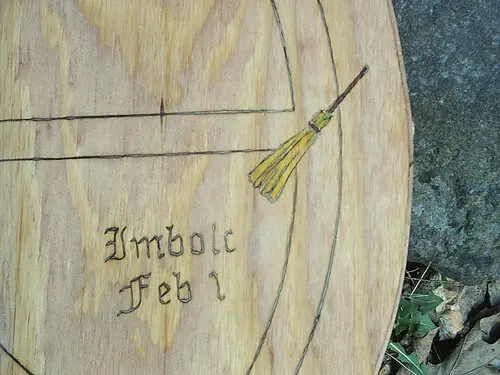
FAQ about Imbolc
Are Candlemas and Imbolc the same?
Not really, because Candlemas is a Christian festival while Imbolc is a pagan celebration and the older festival. Candlemas is more of a Christianized version of Imbolc, which happens on February 2, while Imbolc starts sundown from February 1 to February 2.
The two ceremonies share some themes like cleansing and rebirth, but Candlemas is largely around the presentation of baby Jesus at the temple and Imbolc on the seasons.
Is Imbolc a Fire Festival?
Yes, Imbolc is a Fire Festival, and it is because Brigid is associated with different kinds of fire, including the hearth fire, creative fire, and also the sun fire. Candles and flames are lit as part of celebrations.
How should I dress for Imbolc?
You dress in practical clothes allowing for cleansing and other activities but more importantly, wear colors associated with the celebration. These include white, yellow, red, and pink.
How do you make an Imbolc cross?
You can make an Imbolc cross using ruses/straw and some yarn. You should soak the straw for at least 30 minutes before using them to prevent breakage. Follow these steps.
• Start with two straws and fold both in the middle.
• Wrap the second straw over the first straw closer to the folded end
• Wrap the third straw around the second straw and a fourth straw around the third straw
• Tuck the ends of the fourth straw through the loop of the first straw
• Pull-on the ends to form a box-shaped knot in the middle
• You can add two to three more rows folding them in the same direction as the first one.
• Ensure the ends of the last straw in each row tuck into the loop of the first straw in the row.
How do you make a St Brigid Cross with paper?
You can also make the Cross using strips of paper. For a simple and averagely sized Brigid Cross from paper, fine strips of paper measuring about an inch wide and follow the following step;
• Fold all the strips in half.
• Hold the first strip with its fold on top and the second horizontally with its fold on the left.
• Enclose the first strip in the second in that position
• Get the third strip holding it with its fold facing the bottom, and wrap it around the second strip.
• Hold the fourth strip horizontally with its fold on the left and open it up to enclose the third strip. Tuck the ends of the fourth strip inside the fold of the first strip.
• Gently tighten the knot by pulling the ends to make the Cross.
How do you hang St Brigid’s Cross?
The Cross hangs by the door to either on the wall next to the door or above the rafters. Every New Year requires a new cross.
Why did St Brigid make a cross from rushes?
The Christian origin of the crosses says St. Brigid picked the rushes from the floor in a room where her dying father or a pagan Lord lay. Weaving the crosses helped her pass the time and find consolation, while in the dying pagan Lord’s story, it helped calm his deliriousness, and as she told him of the cross’ significance, it helped convert him to Christianity.
Is Brigid’s Cross pagan?
Yes, while it may have been adopted as part of a Christian symbol, its origins are pagan, representing protection from fire and evil and the pagan sun wheel.
What animals are associated with the goddess Brigid?
Animals associated with the goddess include hibernating animals like groundhogs and badgers, domestic animals like cows, lambs, and ewes, the serpent, bees, owls, the raven, and the falcon.
What comes after Imbolc?
Imbolc is part of the four Gaelic festivals that celebrate the seasons. After Imbolc (February 1), the next festival is Beltane, held on (May 1).
Do you want to learn more about Wicca and Witchcraft? Check out our recommendations at “Wiccan Bookshelf”
Stay in Touch
 Join our newsletter by using the forms on this website or click here!
Join our newsletter by using the forms on this website or click here! Follow us on Google News
Follow us on Google News Follow us on Facebook
Follow us on Facebook
Featured Image: “Brigid’s Cross” by Editor B is licensed under CC BY 2.0

